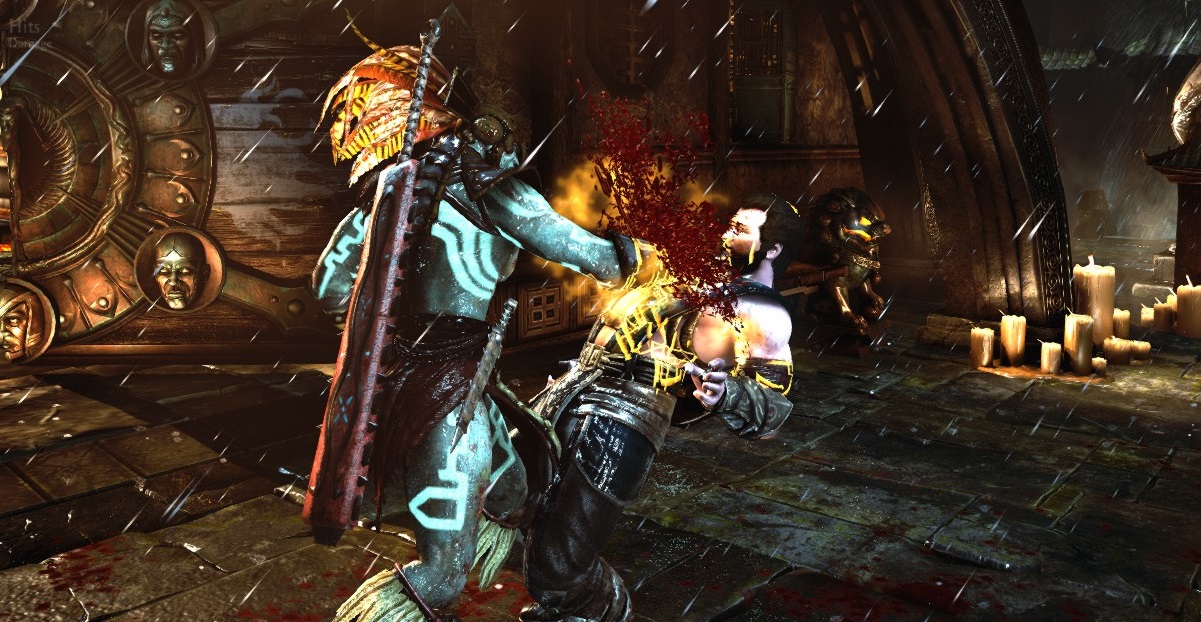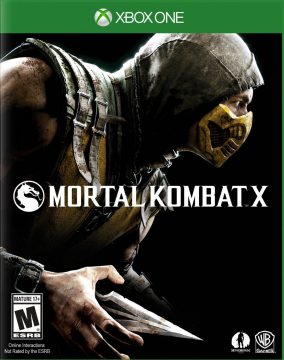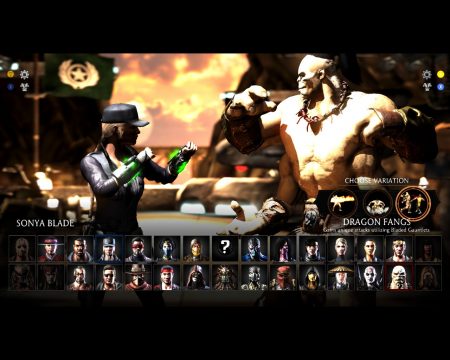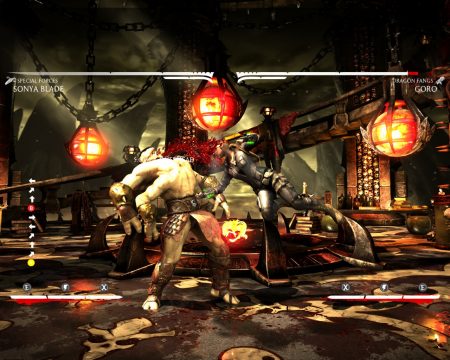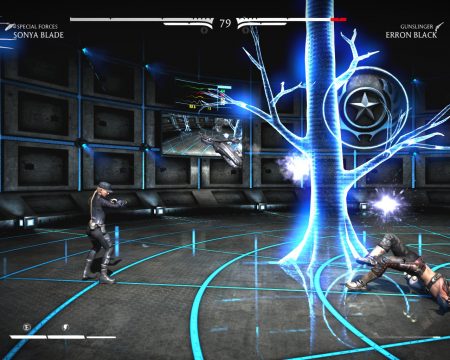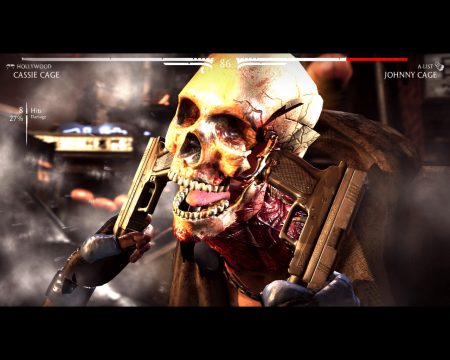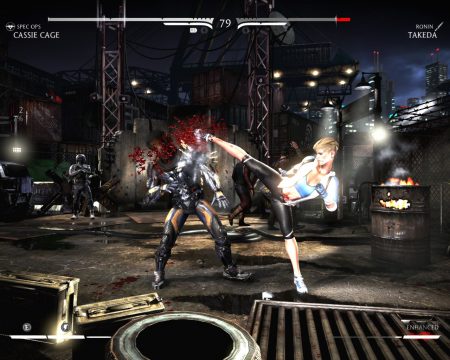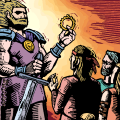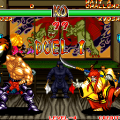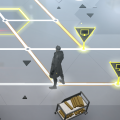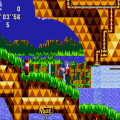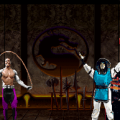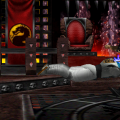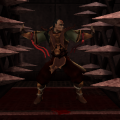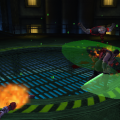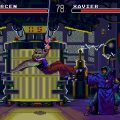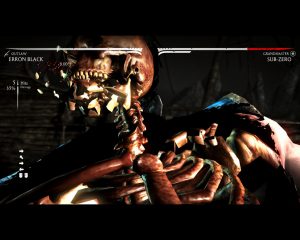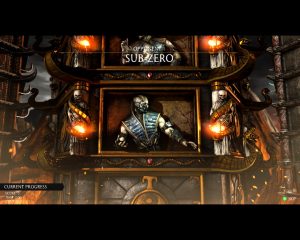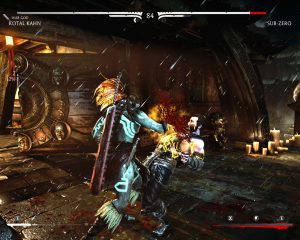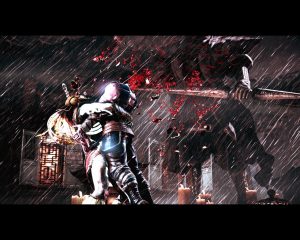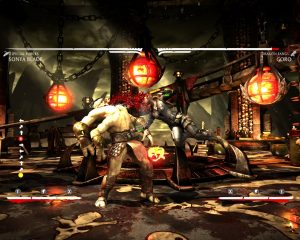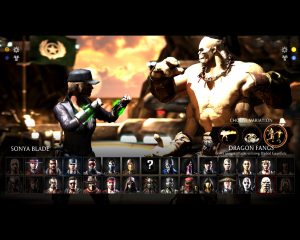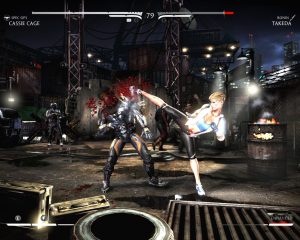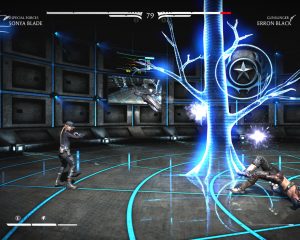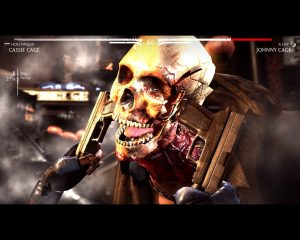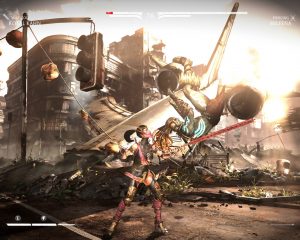- Mortal Kombat (Introduction)
- Mortal Kombat (1992)
- Mortal Kombat II
- Mortal Kombat 3
- Ultimate Mortal Kombat 3
- Mortal Kombat Trilogy
- Mortal Kombat 4
- Mortal Kombat Mythologies: Sub-Zero
- Mortal Kombat: Special Forces
- Mortal Kombat: Deadly Alliance
- Mortal Kombat Deception
- Mortal Kombat: Shaolin Monks
- Mortal Kombat Armageddon
- Mortal Kombat VS DC Universe
- Mortal Kombat (2011)
- Mortal Kombat X
- Mortal Kombat (Miscellaneous)
After its reboot in 2011 was met with immense critical and commercial success, Mortal Kombat finally seemed to be in good hands. While it may not have been an unanimous success, almost everybody could agree that it was a massive step upwards from the games that came just before it. While the DC Comics fighter Injustice was an interesting detour, the immense praise MK 2011 received meant that a sequel was inevitable. While MKX improves on a number of things since the last game, the foundation the reboot set is still there. That’s not really a problem, though, considering that the basic mechanics of the previous game were solid enough that they didn’t need to be completely overhauled once more.
The story of MKX takes place in various points in time, all the way up to 25 years since the previous game. Two years after Shao Kahn’s attack on Earthrealm was foiled, Shinnok, fallen elder god and ruler of the Netherrealm, launches a demonic attack on Earth. Over in Outworld, however, the new emperor, Kotal Kahn, is caught up in a civil war against Mileena, heir of Shao Kahn after his death. To deal with these new threats, Johnny Cage puts together a new squad of young fighters, sent out to investigate the intrigue in Outworld. Unlike MK2011, which was a broad retelling of the original trilogy, this game follows an entirely new plot than MK4 did, with the only thing the games share being Shinnok’s role as main villain.
From the starting roster, sixteen characters make a return appearance from the previous game, including a few who perished in the previous game. (As has been said, not even death can stand against the sheer force that is fan popularity.) Shinnok makes a return appearance from his appearance in Armaggedon, as well, as a playable character as well as the new final boss. Eight new characters join the roster, too, with four of them being brand new additions to the MK universe, while the rest are relatives of the established MK cast. Should you feel like shelling out, you’ll also have a few extra DLC characters to pick from, including the return appearance of the rather forgettable Tanya. The Mortal Kombat XL edition includes all of the DLC, though was only released for consoles.
Despite the fact that new characters to the MK lore always tend to be a bit dicey, given we’ve ended up with winners like Hsu Hao and Kira, all the new additions are all surprisingly worthy. The relatives of the old cast have enough of their own flair and differences that none of them feel redundant. The entirely new additions, however, all bring some interesting new gimmicks to the MK universe. Even Shinnok, as lame as he was in previous appearances, has had a heavy retool in somebody far more menacing, even if he doesn’t quite have the charisma of, say, Shao Kahn.
One particular new feature are three variations of each character that you can choose from after you select your fighter. Each variation adds or modifies a character’s moves and how they play, with each one offering distinct advantages and disadvantages. While every character will have a basic set of special moves they’ll always have, one variation might change the way they work, or give them some exclusive moves. Scorpion, for example, will always have his spear, teleport attack, and his leg takedown, no matter which variation you choose. But depending on what you pick, he might get a pair of katanas, giving his basic attacks more power and range, a demonic minion to interfere with his opponent, or a new set of flame-based special moves. It’s a pretty interesting twist, one that feels sort of similar to Samurai Shodown’s “Bust/Slash” system, and it helps to spread each character even further apart.
The basic mechanics are pretty similar to the previous game at their core, with the same five button layout and the same super meter. If you’ve gotten used to the previous game, you won’t have too difficult of a time adjusting, aside from the game moving a good deal faster since last time. EX moves, combo breakers, and X-Ray moves generally work the same way, although some moves can now be EXed after they hit, adding on damage and sometimes including useful new properties. Characters now have unique animations for air attacks as well, which, given how ubiquitous they are in all fighters, was somewhat embarrassing they weren’t even in the last game.
One extra wrinkle is the Stamina meter under a character’s health bar, bringing back shades of MK3. Stamina can be used to sprint towards opponents by performing a forward dash and then holding the block button. Running, much like how it worked in MK3, can be used to reach opponents quickly, as well as spring right into combos. Combo breakers will now also cost you a full bar of stamina along with two bars of super, which means that they’re not quite as easy to use than the previous game. Finally, stamina can be used to make use of various objects around the arena, a concept seen previously in Injustice.
Every stage has certain objects in the background that can be used by hitting a certain button while standing near them. This includes things like walls that fighters can jump off of to escape corners, statues that opponents can be slammed into, and unsuspecting old women can be chucked at your foe. Interactibles will always be in the same place, no matter what, although some of them can only be used once per match. While interactibles are generally somewhat situational, they can be useful for surprising an opponent, escaping tricky situations, or spending a bar of super to give yourself armor as you use them.
The new changes build on what was already a pretty solid fighting game, and most of the new features never change the game so radically you feel like you have to relearn it. There’s a lot of more minor changes that generally help polish the game further, as well. Things like how the game handles two characters hitting each other at the same time have been smoothed out, as well as adding the option for more Street Fighter-esque special move inputs. There’s even the option to pin move inputs onto the screen as you play, which is definitely handy for memorizing certain moves and combos.
The standard arcade mode makes an appearance, although, sadly, the 2v2 tag mode of the previous game does not. There’s no subboss this time, and the final boss is Shinnok. While he might not have the charisma of Shao Kahn, he’s thankfully far less lame than his previous appearances. Shinnok, the new boss, isn’t quite as hairpulling as Shao Kahn. For the first time in a mainline MK game, however, he actually has a second demon form, giving shades of Mythologies. The challenge towers return, but somewhat disappointingly, these are just a series of regular fights, except with the occasional extra condition plopped onto them. Nothing nearly as interesting making Mileena beat up Scorpion until he accepts her teddy bear, anyway.
One particular interesting feature is that the fighters will actually have a short conversation before a fight begins, and every combination of characters has at least one unique conversation, even mirror matches. While enemies will taunt and threaten one another, established friends and relatives tend to joke around a lot more. Which is a nice touch, except for when you realize this is a series where best friends are not only expected, but encouraged to murder each other. Take this conversation, for example.
Johnny Cage: “You’re a good looking kid!”
Cassie Cage: “‘Cuz I take after mom.”
Johnny Cage: “Well, I’ll try to avoid your face.”
Considering this can lead to Johnny throwing his biological daughter to the ground, grabbing her by the face, and slamming it repeatedly into the ground until her head resembles uncooked hamburger, this ends up being as hilarious as it dark. The game never calls attention to this sort of thing, either, which makes it all the sillier. You think it’d be horrible, but the fact that Cassie can murder her father and take a selfie of it, where her mother even posts a comment about it, makes it slightly okay. Slightly.
The story mode also returns, not much unchanged from the games it previously appeared in. It makes a pretty entertaining watch, with a fight mixed in every so often. If there’s one complaint to be had, it’s the fact that the fact that the game is constantly skipping through various points in time can make things confusing to follow. It’s also, somewhat surprisingly, way less grim than MK2011‘s story, with less major character death and more jokes being thrown around. Overall, much like the previous game, while the story isn’t terribly deep, there’s a lot of fun action scenes and goofy dialogue, which makes it pretty great popcorn viewing. In terms of gameplay changes, however, the only new condition are QTEs that appear at certain points in the story. Every so often, characters will fight it out in a cutscene, and hitting the correct buttons will allow your character to fight back. There’s no sort of penalty for missing any of these, however, so if you’d prefer to watch your fighter get wrecked, go for it.
As before, playing through the game gives you koins, which can be spent in the Krypt. Instead of one large area where everything is in rows to unlock however, it’s been made into what’s basically a miniature dungeon crawler. To find everything to buy in the Krypt, you’ll have to explore in a first-person, grid-based movement system. Some areas of the Krypt are even blocked off, and will require you to pull certain switches and find items like Scorpion’s spear to open the way to more goodies. There are even monster attacks which have to be fought off with a QTE, or else risk losing some koins. It’s a massive amount of effort for one particular feature, and there’s some lovely concept art to find, among other things, if you venture through long enough.
Next generation technology has allowed the violence to reach all new levels, and the game makes use of every bit of it. Every character gets two fatalities, per standard, and a few of them manage to top even the worst of what MK2011had to offer. Dragging a guy in half through a buzzsaw crotch first has nothing on stuffing your sword whip down an opponent’s stomach and tugging out what it catches. X-Ray attacks are even more detailed than before, including showing exactly the kind of effect hitting somebody below the waist hard enough usually has.
There’s also the addition of Brutalities, which, thankfully, are entirely different than their MK3 incarnation. Performing a Brutality requires you to accomplish a certain condition, and then complete the winning round with a certain move. Some of these are easy, like just making sure the final round ends with a throw, while others might make you use a certain variation, using 3 stage interactibles in the winning round, and then finish the round with a certain special move. Should you accomplish this, the move will have some gory new results for the loser. A standard nut punch might lead to a head explosion, a sword swing might lead to the opponent getting sawed in half, and chucking an old woman at your foe may lead to her pummeling the poor guy to death. Brutalities are far quicker than fatalities, but they’re pretty nice for having a gory finish without having to wait for the animation to play out.
If there’s one particular disappointment of the game, it’s the online. The game places a lot of importance on it, including having you select one of the five major factions of the MK universe when you first start up the game. The game gives you certain challenges to accomplish to help bring your faction above the others, from defeating opponents online to winning certain fights under difficult conditions. Your faction doesn’t make much difference, although spending enough time in one will unlock special “Faction Kill” finishers, in which your allies will off your opponent in some way so you don’t have to bother. The “Test Your Luck” mode can now also be played online, bringing the goofy, chaotic fun to your entire friends list.
At the game’s launch, the netcode used to be pretty lackluster, compared to competitors like Skullgirls and Killer Instinct. A patch released later during the game’s lifespan, however, improved the online experience drastically. Unfortunately, it came out a little too late. Even having a ragequitter’s head explode in a “Quitality” doesn’t quite reduce the sting of that entirely.
Overall, Mortal Kombat X doesn’t really as much of a leap from MK2011 and the games that came before it. On the other hand, it doesn’t really need to be, since its predecessor did so much better as a functional fighting game. At the time of this writing, however, there’s so many more modern fighting games to pick from, some of which easily outclass MKX in terms of features like online play. It’s still a fine fighting game, however, even if the overall improvements from the game before it aren’t very massive. If you’re the sort of person that just didn’t gel with MK9 in general however, there might not be a whole lot to change your mind.
At launch, the game’s PC port was nothing less than an absolute trainwreck of a launch, missing almost the entire game when downloaded, and requiring several redownloads just to get it to work. Even then, it was glitchy, prone to crashes, used up memory at an alarming rate, and was just kind of a mess overall. Nowadays, it’s playable, but certainly doesn’t run as well as what the console versions have to offer. Morever, WB Games, MKX‘s publisher, have decided to cancel all support for the PC version, including promised improvements to the netcode and four new DLC characters. Steam users likely won’t receive any kind of refund over this. Business practices like these are best left unsupported, which means, even if MKX is a fine game on its own, you should consider if you really want to reward this behavior with your money before you decide to buy it.
Besides the variety of fighting games they’ve released, Netherrealm has also made a handful of different mobile games, all of them following off from the success of games like Infinity Blade and featuring similar gameplay. MKX is the newest in this lineup, not really offering much from previous games in the style, like the mobile version of Injustice: Gods Among Us and WWE Immortals. If you’ve played one of those games, you know more or less what to expect. If you haven’t, you aren’t missing terribly much.
The mobile version of MKX basically functions as a stripped down fighting game, with controls based around the touch screen. Each player gets a team of three characters that they can pick from their available roster, and the first player to defeat all the characters on the enemy team wins the match. Characters constantly stand right in front of one another, which makes combat simply a matter of rapid tapping with the occasional swipe. About the only real depth is knowing when to swap out damaged fighters and building up meter to perform special attacks, some of which plant debuffs on your opponent. Other than that, it’s pretty mindless, since it all basically boils down to tapping on the screen as quickly as you can. Sure, you can block, but most attacks from your opponent come out so quickly you have no warning, or they do so much damage you may as well not bother.
The problem is that it’s just all so very repetitive, whether you’re playing by the single player mode or challenging opponents online. Every match plays out basically the same, no matter what character you’re using. There’s been pretty much no effort made to match the skill and tactics of the console version of the game, which means that, if you had good enough stats, you could more than likely beat matches by closing your eyes and tapping rapidly across the screen.
To actually play competitively, however, you’re going to need tons of currency to level up your characters. And not just in game currency, as this is one of those mobile games that makes you pay for every little thing, from allowing a character to partake in more fights, to upgrading their stats in tiny little increments, and so on. And if you want to have any chance of being decent, or unlocking any of the myriad of extra characters and costumes, you’d better be ready to shell out for the premium currency, as the game barely gives you any, should you decide not to put any actual money towards the game.
Really, the only real point of playing this at all is that playing for long enough will eventually give you benefits in the console version of MKX, like experience for the online multiplayer, and some of the goofier costumes available in the game. So if you want to see Johnny Cage dressed as a mime, you’d better have the disposable income to pay your way to it, or you’re going to sprain a finger.
It’s at least pretty enough for a mobile game, although the models look more similar to something you’d see from a late PS2 game. All the fatalities and X-Ray moves are carried over pretty faithfully, at least, although a lot of the gory flourishes are missing. Overall, though, unless you desperately need every piece of content for the console version, you’re best off not wasting your time with this, even if it’s allegedly for “free”. Games like the mobile version of Street Fighter IV might not be exactly comfortable to play on a touchscreen, but it’s still leagues beyond this particular cash-in as far as being a game goes.
